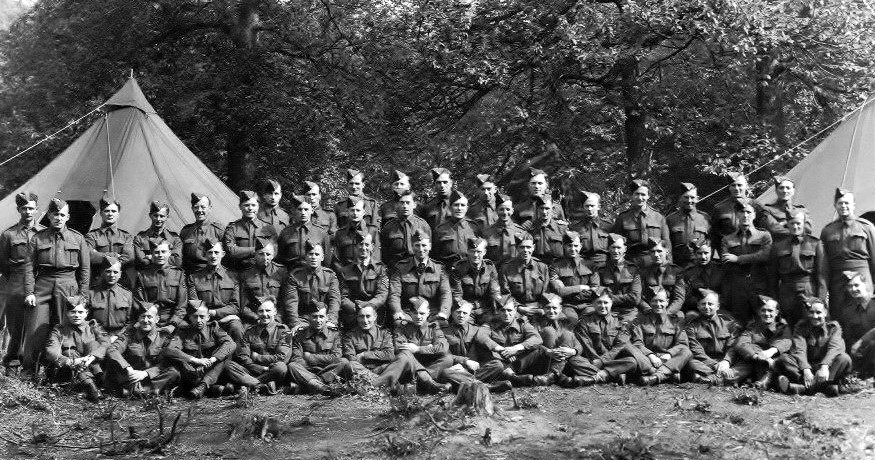
Picture courtesy of Andrew Coel whose father LAC Kenneth Martin Coel (928456) is 8th from the left of those standing.
No. 974 RAF Beach Balloon Squadron consisting of Nos. 51 and 52 Beach Balloon Flights, helped to protect the beaches in the JUNO area during Operation NEPTUNE, the assault landings in Normandy, France – D-Day, 6th June 1944.
There is no Operations Record Book available for No. 974 Squadron during its period as a Beach Balloon Squadron. The original 974 Squadron had been based in the Middle East and the record for the Squadron jumps from the return from the Middle East to the re-formation of the Squadron in the Autumn of 1944, in the U.K., for the return to the Continent as a Port Balloon Squadron. The information we have about the Squadron’s activities as a Beach Balloon Squadron comes from other sources, principally the ORB of No. 2 RAF Beach Squadron.
In January 1944, two Beach Balloon Units from No. 958 Balloon Squadron were attached to No. 2 RAF Beach Unit. No. 51 Beach Balloon Unit was to be located with No. 103 Beach Section and No. 52 Beach Balloon Unit with No. 104 Beach Section.
No. 51 RAF Beach Balloon Unit joined No. 103 RAF Beach Section for Exercise “ROUNDABOUT” with No. 7 Beach Group on 4th January 1944. When they returned from this exercise on 12th January, No. 51 Beach Balloon Unit was located with No. 103 RAF Beach Section for training, and on 14th January they moved to the Highcliffe Hotel, Bournemouth.
No. 52 RAF Beach Balloon Unit went to the Beach Group Practice Camp at Gullane on 14th January to participate in Exercise “ROUNDABOUT” with No. 104 RAF Beach Section and No. 8 Beach Group. On completion of the exercise on 26th January, No. 104 Beach Section returned to Bournemouth and No. 52 Beach Balloon Unit were located with them for training.
Nos. 51 and 52 Beach Balloon Unit went off to No. 12 Balloon Centre, Titchfield on 31st January for training in beach duties.
In April 1944 Nos. 51 and 52 Beach Balloon Units were renamed Beach Balloon Flights and formed into No. 974 RAF Beach Balloon Squadron. Control of the Beach Balloon Squadrons was now passed from Headquarters, Balloon Command to Headquarters, 2nd Tactical Air Force. Squadron Leader A.E.L. Hill, arrived from No. 12 Balloon Centre, Titchfield, to command No. 974 RAF Beach Balloon Squadron.
On 26th April No. 51 Beach Balloon Flight rejoined No. 103 RAF Beach Flight, attached to No. 7 Army Beach Group and No. 52 Beach Balloon Flight rejoined No. 104 RAF Beach Flight, attached to No. 8 Army Beach Group. (The Beach Sections had been renamed Beach Flights and the Beach Units had been renamed Beach Squadrons)
Exercise “FABIUS III” took place at the beginning of May 1944. No. 51 Beach Balloon Flight suffered 50% balloon casualties (15 balloons) owing to adverse weather conditions.

Squadron Leader Hill, the Commanding Officer of No. 974 RAF Beach Balloon Squadron was the cousin of Brigadier S.J.L. Hill who commanded the 3rd Parachute Brigade in Normandy. Both were contacted by Alexander McKee and provided personal accounts for his book “Caen: Anvil of Victory” (Souvenir Press, London, 1964) The quotes about Squadron Leader Hill that follow are from this book.
Squadron Leader Hill went in with the first wave on D-Day, ‘having arranged to meet up with his men on the beach shortly afterwards. They said he wouldn’t. ”You’ll have been shot by then, sir.”’ The tide was coming up fast when Squadron Leader Hill’s AVRE-carrying LCT. arrived near Bernieres, and the beach obstacles were already awash; ‘the LCT. went straight at them, crashed through and lowered the ramp. “Can I come inside?” Hill shouted to the commander of the leading AVRE “No! If I stop on the beach to let you out, I’ll get shot!” So Hill clung to the outside of the tank as it splashed ashore, then dropped off dry further up the beach. Dumping his kit and bedroll by a hidden pillbox (from which, thirty minutes later, a Canadian serjeant flushed eight dazed Germans).’ Hill went for a stroll in the village. ‘Canadians, Germans, and a few French were milling around; he noticed particularly a nice-looking girl arm-in-arm with a very tall German holding a dog on a lead. Then he went back to the beach, and sat patiently on his shooting stick, to wait for the landing craft carrying his barrage balloons.’
Squadron Leader Hill didn’t get shot, in spite of his men’s prediction, but he lost his jeep. His jeep, containing his camp kit and various other items of equipment, was crossing the channel in LCM 229. Unfortunately, LCM 229 broke down in mid-channel. With the jeep was AC1 J.E. Smith (1378458), Motor Cyclist, who was the driver. All on board were picked up by the minesweeper H.M.S. Poole, but the jeep and its contents were lost along with the LCM (See more about LCM 229 at this page about 601 LCM Flotilla)
Other personnel of 974 Beach Balloon Squadron were not so lucky as the unscathed Squadron Leader Hill. We know from Andrew Coel that his father, LAC Kenneth Martin Coel (928456), a member of No. 51 RAF Beach Balloon Flight, had to swim ashore after the landing craft he was on was blown up by a drifting mine. LAC Coel had a broken hip; he was taken to a church for treatment and put back on the beach overnight awaiting embarkation back to the UK. He then spent 6 months in hospital in Barnsley.
Around 21.00 hours on 6th June, an enemy bomb hit a Rhino Ferry beached on MIKE Red Beach. Wing Commander Gates, Balloons Staff Officer, and a few other RAF personnel were seriously wounded. With Wing Commander Gates out of action, Squadron Leader Hill was to take charge of all the Beach Balloon Squadrons in the beachhead.
On D+1, (7th June), Corporal A. Brookes (869570), a 41 year old Balloon Operator with No. 52 Balloon Flight, was killed by a German mine which exploded while he was carrying out his balloon duties. His body lay in an extensive minefield and it was some days before it could be recovered from the minefield and buried.
On 9th June, LAC W.N. Edwards (654417), an M.T. Driver of No 974 Beach Balloon Squadron, who had been wounded in an enemy air attack was admitted to a Field Dressing Station and then evacuated to U.K.
In the evening of 11th June, LAC L. Westwood (1184911), a Balloon Operator of No. 974 Beach Balloon Squadron, was wounded in the face and shoulders by an enemy mine. He was admitted to the Field Dressing Station and thence evacuated to U.K.
14th July was Bastille Day and No. 104 Beach Flight and No. 52 Balloon Flight attended a church service and procession organised by the Mayor of St-Aubin-sur-Mer. A parade of 50 airmen from the two Flights laid a wreath at the Military Cemetery. This was said to be a very good turn-out which favourably impressed the civilians.
No. 974 RAF Beach Balloon Squadron returned to the UK at the end of September 1944, arriving at R.A.F. Wythall on 1st October. Early in November it began re-forming as a Port Balloon Squadron with two Port Balloon Flights, each with 25 Mk VI balloons. One of these was No. 104 ‘P’ Balloon Flight, already on the Continent, the other, No. 103 Flight forming in the U.K. The new 974 Squadron was moved to Belgium in December 1944 to give balloon protection along the Scheldt Estuary near Antwerp
Apart from the sources mentioned above, the main source of information on this page is the Operations Record Book of No. 2 Beach Unit (Later) No. 2 R.A.F. Beach Squadron including Nos. 76 and 77 Beach Units, May 1943 – Sep 1944 – found in, ‘Air Ministry and Ministry of Defence: Operations Record Books, Miscellaneous Units’ AIR 29/438 at The National Archives
